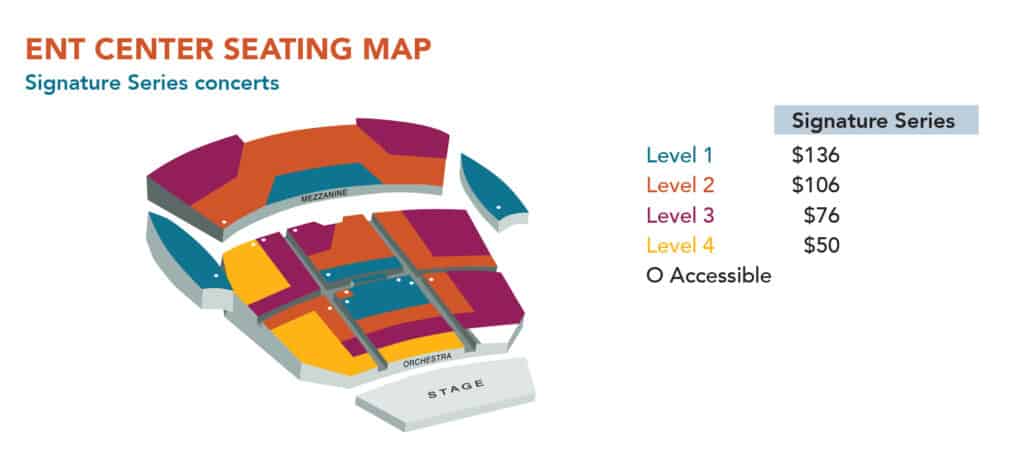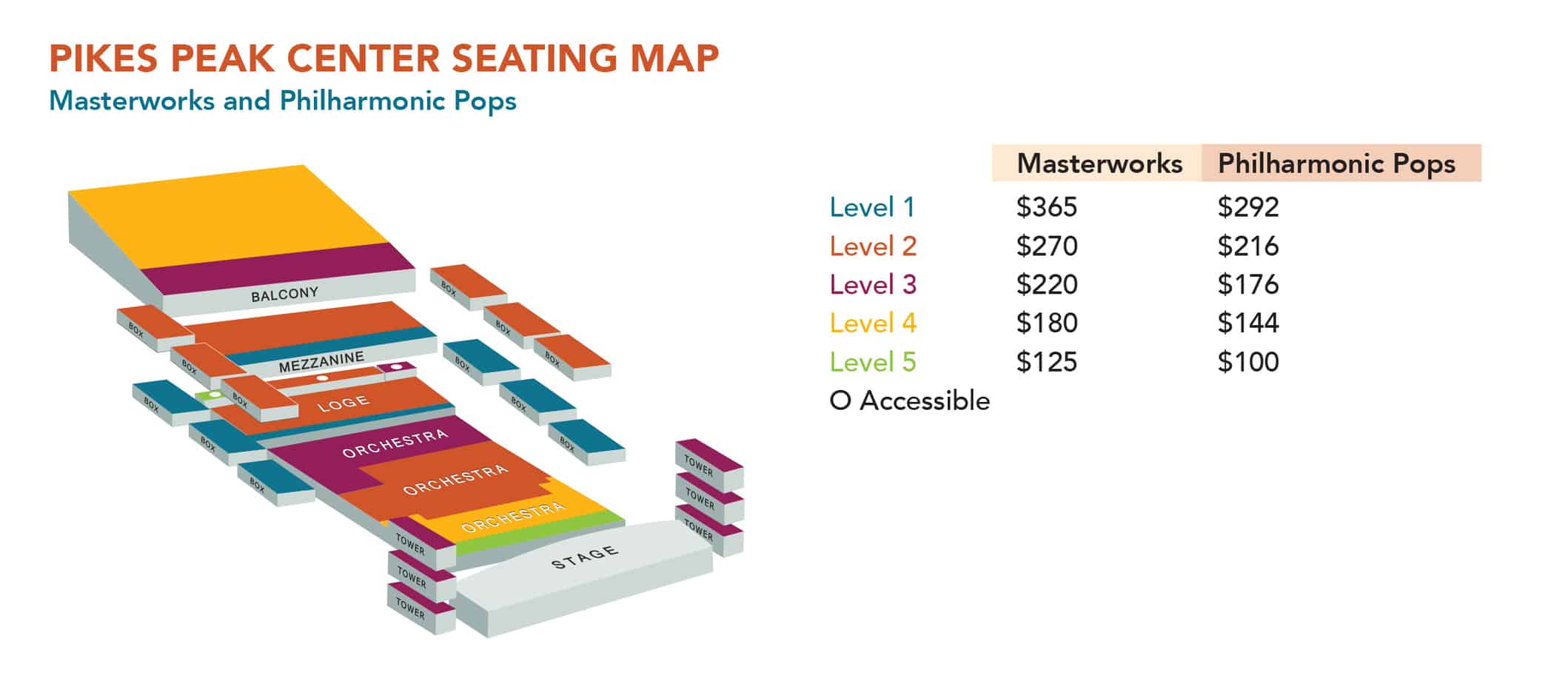Valerie Coleman (Born 1970)
Umoja, Anthem of Unity for Orchestra
Approximately 12 minutes
Composer: Valerie Coleman (Born in Louisville, Kentucky in 1970)
Work composed: original version for female chorus in 2000; orchestral version (commissioned by the Philadelphia Orchestra) in 2019
Work composed: The Philadelphia Orchestra conducted by Yannick Nézet-Séguin premiered Umoja on September 19, 2019 in Verizon Hall at the Kimmel Center in Philadelphia, Pennsylvania
Instrumentation: piccolo, 2 flutes, 2 oboes, English horn, 2 clarinets, 2 bassoons, 2 horns, 2 trumpets, trombone, bass trombone, tuba, timpani, percussions (snare drum, bass drum, temple blocks, triangle, large drumset-“ride” cymbal, suspended cymbal, crash cymbals, tambourine, glockenspiel (bells), xylophone, marimba, vibraphone), harp, piano, strings
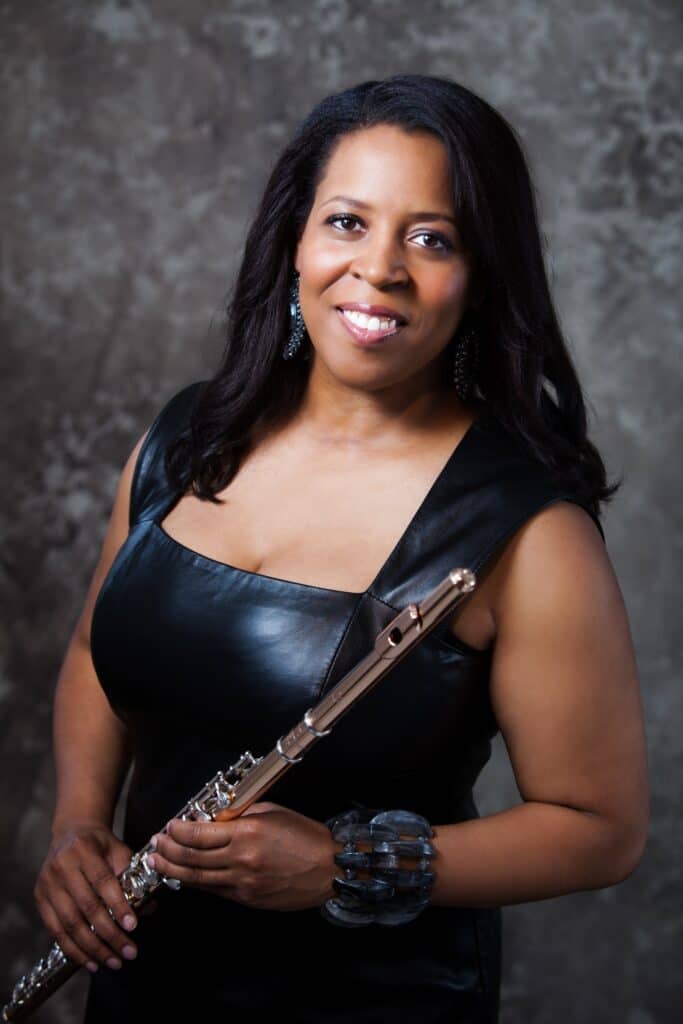
Valerie Coleman is one of America’s most versatile and talented contemporary musician-composers. Among her many public recognitions, The Washington Post named her one of its “Top 35 Women Composers” and she was named Performance Today’s “2020 Classical Woman of the Year” – a prestigious honor recognizing her significant and unique contributions to classical music. And her contributions are indeed many. Highly active as a performer and a flutist, Coleman has appeared all around the country collaborating with a wide variety of musicians and genres, including the Imani Wind Quintet, which she founded in 1997. And Coleman has been even more in demand, and celebrated, as a composer. She has been commissioned by dozens of top-tier orchestras and chamber groups across the country, and in 2002, her Imani Wind Quintet’s signature piece, Umoja, was listed as one of the “Top 101 Great American Works” by Chamber Music America. So successful has Umoja become that in 2019 the Philadelphia Orchestra commissioned Coleman to make a full orchestral version of the piece for them. Umoja’s premiere in that same year marked the very first time the Orchestra had ever performed a work by a living African American woman composer.
The very first version of Umoja, however, was composed over twenty years ago for female chorus and entitled Umoja, The First Day of Kwanzaa. Umoja’s name comes from the Swahili word meaning “Unity,” and in America is connected to the first principle that’s celebrated on the first of the seven days of Kwanzaa. Coleman described that original version as embodying tribal unity “and the sense of a ‘drum circle’ in which participants are sharing oral histories together.” Since then, its beautiful “short and sweet” melody has served as a sort of evolving musical talisman for the composer. Umoja has subsequently been reimagined for many other ensembles – each time met with greater popularity – but especially popular in its version for her Imani Wind Quintet. And then came its orchestral “sibling,” as Coleman calls it, in 2019 for the Philadelphia Orchestra.
The conductor’s score provides this description for Umoja’s 2019 orchestral version:
“… the orchestral version brings an expansion and sophistication to the short and sweet melody, beginning with sustained ethereal passages that float and shift from a bowed vibraphone, supporting the introduction of the melody by solo violin. Here the melody is sweetly singing in its simplest form with an earnestness reminiscent of Appalachian style music. From there, the melody dances and weaves throughout the instrument families, interrupted by dissonant viewpoints led by the brass and percussion sections, which represent the clash of injustices, racism and hate that threatens to gain a foothold in the world today. Spiky textures turn into an aggressive exchange between upper woodwinds and percussion, before a return to the melody as a gentle reminder of kindness and humanity. Through the brass led ensemble tutti, the journey ends with a bold call of unity that harkens back to the original anthem.”
This version of Umoja showcases Coleman’s extraordinary gift for orchestration (the use of particular instruments, and their groupings together, for particular sounds). Immediately heard in the very opening bars, Umoja’s introductory section evokes a stunning beauty and ethereality – as though we are hearing the very moments of dawn, awesome in its infinite quiet. To do this, Coleman sets up a sense of vast space by using a sparse array of instruments to play long-held notes, which are gently pulsed along by occasional pizzicatos (plucks) in the strings and harp, and single notes played by the piano. Meanwhile, the vibraphone, glockenspiel, and marimba (all three, pitched percussion keyboard instruments) are made to ring by using double-bass bows to vibrate their bars like strings – the three instruments soar above the rest of the orchestra with luminously ringing notes. This introductory moment is marked by Coleman to be played in a “Serene” manner, and the effect is goose-bump making.
Out of this rich soundscape, a solo violin emerges playing the simple and lyrical Umoja melody, a short tune of only a few measures. The orchestra begins to become more active with its pulsing – more repeated notes on the piano and the harp, more pizzicatos in the strings, and now struck-notes (not bowed) on the marimba, all of it creating a feeling of blossoming in the orchestra. Another delightful orchestration technique that Coleman uses is to give the Umoja melody to various and surprising instruments – next the trumpet but with a particular kind of muting, then the piccolo – all of this to begin gathering the disparate voices into Umoja’s unity.
But as the orchestral forces begin to come together, the brass and percussion continually interrupt that unity with outbursts of angry splashes of color and energy. Throughout, Coleman also employs a nifty layering technique, where a single solo motive begins and then continuously repeats, and over top of that, additional and different motives are layered onto it. The result is the musical equivalent of a woven fabric, with the designs emerging through layered threads. A great example of this happens at about nine-and-a-half minutes into the work: first, the violas play a somber version of the Umoja melody, then added to that is a short rhythmic pattern from the cellos, then the bassoons with some virtuosic little eruptions, which are then added to by the upper winds, followed by the upper strings with the Umoja melody in a more spritely character – all of this layering builds to a wonderfully dense section for the full orchestra together, which grows into an exhilarating climax with the French horns singing majestically. By the end of the piece, unity is indeed achieved as the entire orchestra comes together to give the Umoja anthem their full voice, and the effect is thrilling. As a last touch, the clarinet and bassoon share a brief, quiet duet of the Umoja melody, recalling that unity begins small – as it did at the very beginning with the solo violin – but ends big, as all the orchestral instruments conclude this delightful work with a valiant and grand crescendo.
“Now, more than ever,” says Coleman, “Umoja has to ring as a strong and beautiful anthem for the world we live in today.”
Maurice Ravel (1875-1937)
Piano Concerto in G Major
Approximately 22 minutes
Composer: Maurice Ravel (Born in Cibourne, Basses-
Pyrénées, France on March 7, 1875; died in Paris on
December 28, 1937)
Work composed: 1929–1931
World Premiere: Pianist Marguerite Long premiered the Concerto on January 14, 1932 at the Salle Pleyel in Paris with the Orchestre Lamoureux conducted by Ravel.
Chicago Musical College (Chicago, Illinois) in 1934, with
Florence Price as the piano soloist
Instrumentation: solo piano, piccolo, flute, oboe, English horn, 3 clarinets, 2 bassoons, 2 horns, trumpet, trombone, timpani, percussion: (triangle, snare drum, cymbals, bass drum, tamtam, wood block, whip (typically played by slapstick: two boards slapped together), harp, strings
Piano Concerto in G Major
I. Allegramente
II. Adagio assai
III. Presto
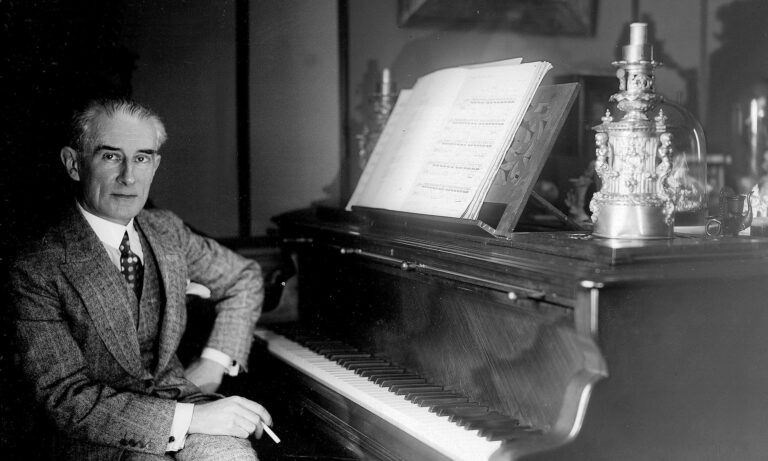
Maurice Ravel is considered one of France’s foremost Impressionist composers, but classifications can be slippery. His exceptional Piano Concerto in G, completed in 1931, for example, defies this classification as much as it reflects Ravel’s many interests and marvelous uniqueness as a composer. From his Swiss engineer father, young Ravel gained an undying fascination with machines and in the late 1920s (by then a mature composer), he had even imagined the possibility of composing a work played entirely by factory machines. In later years, he spent many hours making fantastic little mechanical toys for his two godchildren. An even stronger influence was born of his Basque mother, who fostered in Ravel a lifelong love of Spanish music – besides his hugely popular Bolero (1928), Ravel composed several other Spanish-influenced works (for example, his extremely popular 1908 Rhapsodie Espagnol). He was equally enamored with old music, such as the music of Bach and of the Renaissance, as well as the new, especially the “new” American jazz. Most of these influences are reflected in his Piano Concerto in G, but where one might expect a hodgepodge of styles, when melded by Ravel’s genius, the Concerto is a wonderfully imaginative, eclectic, and delightful masterpiece, and surely one of his most beloved works.
The splendid and unusual opening to this Concerto sets the whimsical and witty stage for its first movement, Allegramente (cheerful with a lively tempo). It seems to conjure up those fantastical little toys that Ravel created for his godchildren. A slapstick cracks (Ravel scored this cracking sound for a whip), opening the scene to what might be a room filled with bizarre little mechanical creatures marching about, rhythmically busy in their curious quests. Ravel portrays these robotic antics, in part, with a snare drum roll sounding like a mechanical ticking of a wind-up toy set loose, while the piccolo plays a furtive, rather confused little march melody. The pianist is in the middle of the fray, too, quietly playing maniacally fleet triplets upwards and downwards, roiling up the mechanical creature’s little atoms. It’s a delightful musical scene of a fantastical world of whimsical wonder. But soon, at about one minute, the busyness and furtiveness are wound down by a squeaky solo in the English horn, and the piano then lushly spins a bluesy, sensually Spanish-tinted tune, completely aloof from the chaos of just moments ago. Early sketches of a previous, but unfinished, work by Ravel – a Basque rhapsody called Zaspiak bat – are thought to appear in the first and last movements of this Concerto – certainly a Spanish flavor is obvious. Ravel’s love of jazz also slips into this Spanish-hued section – you can hear bluesy-sounding chords and brief little repeating jazzy riffs blended all through this section. This movement’s play of rhythmic drive, sometimes whimsical, sometimes frightful, against the sensual and sultry, are the continuously contrasting agents of this wonderfully entertaining first movement. Among its many musical joys, at around five minutes into the movement, the music wanders into a prolonged solo from the harp, like a mini cadenza, which seems to evoke yet another magical universe – fairy-like with gossamer glissandos (sliding between several pitches) strumming continually up and down the harp strings, with fantastical orchestral effects, such as glissandos in the strings, accompanied by flutter-tongued passages (like rolling an ‘r’ with the tongue while playing) in the piccolo, clarinet, and trumpet. The completion of the harp cadenza then sets off a cascade of miniature and fanciful cadenzas, next for the bassoons then piccolo, and finally settling into the solo piano. The movement closes with rumbles in the low registers of the piano with a hard driving rhythm, gathering up its instrumental automatons along the way, until every voice in unison marches to a vibrant close.
Ravel had strong opinions about the nature of concertos, famously accusing Brahms of writing concertos “against the piano,” their gravity so relentless. For his Concerto, however, Ravel had toyed with calling it a divertissement, which more than a century before him referred to the music that filled the gaps between set changes in French operas and ballets – a musical diversion intended to entertain and delight the audience. Ravel’s divertissement approach might help to explain the seeming incongruity between the three movements of his Concerto. Where the first was full of frenzy, fancy, and curiosities, the second movement, Adagio assai (very slowly), is filled with the most sincere and beautiful music that Ravel ever created.
This Adagio begins with the piano alone, quietly tapping out an unadorned accompaniment in the left hand for an unhurried waltz. A long and hushed melody, comprised only of single notes (without chords), then gently blends in from the soloist’s upper hand, simple and contemplative, as if in the throes of a deep reverie. Blissfully wandering for some 32 measures, this exquisite piano solo proceeds for three extraordinary minutes until it eventually becomes enveloped by the rest of the orchestra – the piano trills delicately and the strings drifting in with long-held notes sounding like soft breezes, while various solo winds then briefly trade off smaller portions of the piano’s blissful melody. Most remarkable about this long melody is how the accompaniment (in the left hand) is written to sound as if it’s in a slightly different meter than the right-hand melody, creating a mesmerizing kind of rhythmic gravitational pull towards each other. At about six minutes, after a long build up to a briefly discordant climax, a solo English horn then takes over the piano’s original long melody, underneath of which the piano softly rhapsodizes. With the sadness suggested by the solo English horn against the whispered, unfettered floating in the piano, this is one of the most hypnotic moments in the entire Concerto. Yet as seamless and naturally flowing as this lovely movement is, Ravel in fact struggled more with this movement than any other in his career, bringing him to such despair that he admitted to the Concerto’s dedicatee, Marguerite Long (who was also the pianist who premiered the Concerto), that he composed it two, and sometimes only one, measure at a time. The ending melts into the quiet of the night with the piano trilling quietly and the strings fading into silence.
Completely changing scenes again, the third movement, Presto (quickly), begins with a comical four-chord motive – four obnoxious chords played in the brass, bassoons, and low strings, sounding like horns blaring in traffic, and punctuated at the end with the thud of the bass drum. Immediately a feverish flurry is unleashed, and soon an E-flat clarinet (notorious for its ability to squawk), piccolo and glissandos in the trombone, start caterwauling until the pompous opening four-chord motive shuts them all down. This movement is a Ravellian carnival – full of fast and quickly changing scenes, amusingly bordering on pandemonium, and its vaudeville air is utterly delicious. Pianistic virtuosity plays throughout the tableaus with breathlessness, amidst bumbling chaos and changing tonalities. All the while, Ravel’s uncanny gifts for orchestration twirl in a hyper-speed kaleidoscope. A particularly dazzling moment occurs at about two minutes into the movement. The cellos begin a long run of a maelstrom of fast notes, which overflows into the bassoon (in a particularly virtuosic moment for this instrument), which then overflows into the piano – this section builds with various instruments being added bit by bit, with increasing energy, like a boiling volcano. But rather than conclude into the expected cataclysmic explosion, the music instead wanders off while the piano solo plays a kind of unhinged little solo. It’s wonderfully exhilarating and comically crazy. And to keep everything from derailing, the obnoxious four-chord motive continually appears to force a kind of reset. The final bars are like a mad dash to stage left, and, naturally, concluded by the clamorous four-chord motive and the thuddiest of bass drum hits – leaving the orchestra and soloist winded and the audience delightedly dizzy.
Antonin Dvořák (1841-1904)
Symphony No. 9 in E minor, “From the New World”, Op. 95,
Approximately 40 minutes
Composer: Antonin Dvořák (Born in Nelahozeves, near
Prague, Bohemia (now Czech Republic) in 1841; died in
Prague in 1904)
Work composed: 1893
World premiere: The premiere was held at Carnegie Hall on December 16, 1893, performed by the New York Philharmonic and conducted by Anton Seidl.
Instrumentation: 2 flutes (including piccolo), 2 oboes
(including English horn), 2 clarinets, 2 bassoons, 4 horns, 2 trumpets, 3 trombones, tuba, timpani, percussion (triangle, cymbals), strings
Symphony No. 9 in E minor, “From the New World”, Op. 95
I. Adagio – Allegro molto
II. Largo
III. Scherzo – Molto vivace
IV. Allegro con fuoco
I. Adagio – Allegro molto
II. Largo
III. Scherzo – Molto vivace
IV. Allegro con fuoco
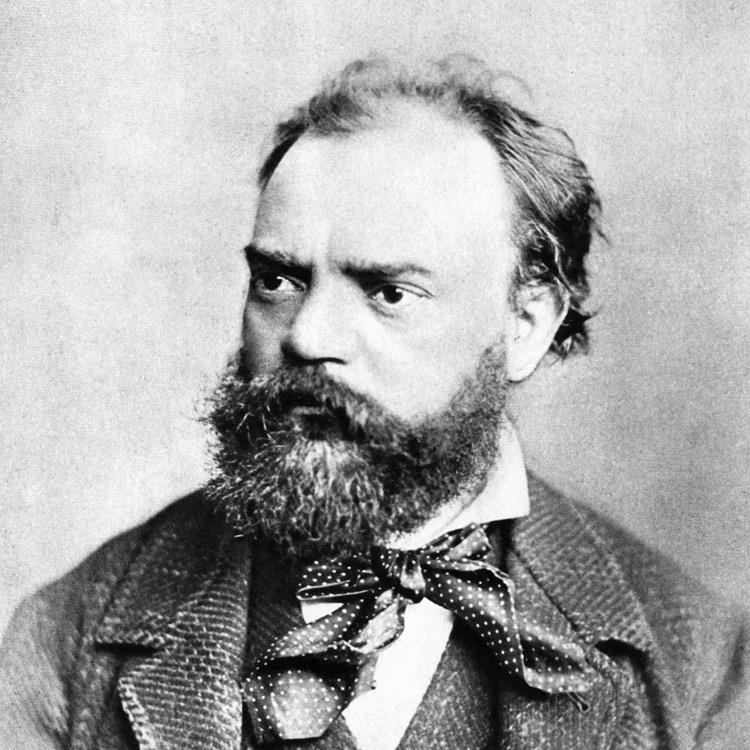
By 1892, Czech composer Antonin Dvořák had been steadily growing a reputation in Europe and America as a great Romantic Nationalistic composer. It was in this year that the American philanthropist, Jeanette Thurber, invited Dvořák to America to be the Director of her new music conservatory. Thurber’s National Conservatory of Music in New York City was, besides being a place of expert musical instruction, committed to creating a suitable Nationalistic American music. Thurber hoped Dvořák would help America find that national style, and she made a three-year offer the Czech composer could barely refuse: a salary of $15,000 per year (the equivalent today of almost $500,000), a three-hour-a-day work schedule, and four months of vacation a year. Dvořák accepted the directorship, and began his duties that same year in 1892 – but based on the condition that African Americans and Native Americans be allowed into the Conservatory regardless of their ability to afford it, a condition that was kindly obliged. This condition turned out to be pivotal in leading Dvořák to form his concept of a genuine American style of music.
One of Dvořák’s students was African American singer Harry T. Burleigh. Burleigh became Dvořák’s assistant, and soon taught the Czech composer about African American Spirituals – after his Conservatory years, Burleigh would become an important American composer in his own right. Thanks to Burleigh’s tutelage, and other sources of African American and Native American people’s music, Dvořák wrote a series of articles that first year, stating, in part:
“I am convinced that the future music of this country must be founded on what are called Negro melodies. These can be the foundation of a serious and original school of composition, to be developed in the United States. These beautiful and varied themes are the product of the soil. They are the folk songs of America and your composers must turn to them.”
While the whole country was celebrating Dvořák’s presence, in 1893, the New York Philharmonic commissioned Dvořák for a new symphony. He completed it quickly and it had its premiere with the Philharmonic in December of that year at Carnegie Hall, titled Symphony No. 9 in E minor subtitled “From the New World” and was described as being inspired by the very “folk songs” that Dvořák had talked about in his articles. This was a conceptual inspiration, for Dvořák created all of his own themes for the work. The Symphony was an ecstatic success at the premiere, the audience gave standing ovations between each movement, insisting that Dvořák stand and take a bow. It was the greatest success of Dvořák’s career, and the Symphony quickly became a sensation all over the world. Today, it is widely acknowledged as the most popular symphony ever written.
A wonderfully unique feature of the New World is that each of the four movements begins with an introductory section, and these introductions deliver much of the thematic material for the entire Symphony. The introduction to the first movement, marked Adagio (slowly), begins as though it’s the start of an epic tale, with a “once upon a time” feeling to it. Starting in the lower strings, the violas, cellos, and basses play a short motive that repeats several times, each time sinking a little lower, until it comes to rest. At that point, the horn plays a valiant call, just two notes, as if a heralding to arms. This soon leads to some violent solo outbursts in the timpani and full orchestra, and the music begins to take on more rhythmic activity. Listen for the violas, cellos, and horn when they play a rising, then falling motive under tremolos (shimmering) in the upper strings – it will play an important role in the music to come. The introduction comes to an aggressive climax, then fades off with a timpani roll, until the body of the movement begins with the Allegro molto (very fast). The rising-falling horn motive from the introduction returns immediately in the horns, now majestically regal as if sounding the call to a noble undertaking. The movement then moves through waves of energy and climaxes, then settling down into moments of exquisite lyricism, and then building up again. Each time, the underlying energy seems to grow more vigorous, until at about nine minutes, when the closing section begins. A buildup of orchestral forces here then barges into a new key, and the last measures are filled with trumpet and horn calls until the final, emphatic bars.
The introduction to the second movement, Largo (slowly and dignified), is one of the most moving moments in the Symphony. Low winds and brass begin a slow-moving chorale, only four bars long, which carry us far away from the energy of the first movement. The chorale’s chords are dark, yet not filled with pathos, but rather filled with the sense of introducing something extraordinary – and the melody that immediately follows is indeed that. Perhaps one of the most cherished melodies that Dvořák ever penned, the English horn sings a long, beautiful, and yearning melody overtop long-held notes in the strings. Soon, the clarinets add a counter melody in autumnal hues to the English horn’s solo song. It’s a moment that seems as though time has almost stopped, and everything melts in earthy, comforting hues. Dvořák reportedly first wrote this famous solo for clarinet, but then changed it to the English horn because it reminded him of his student, Harry Burleigh’s, exceptional voice. An equally exquisite moment happens at about five minutes. Here, the winds play a long note chorale over top of a kind of “walking bass” – where the string basses provide a steady, moving line with pizzicatos (plucked) – and in between, the strings create an occasional oscillation, like zephyrs stirring leaves. A brief climax then builds up to a surprise visit of the first movement’s rising-falling horn motive, and the movement then returns to the English horn solo, trading it with the violins, at times, taking long moments of poignant silence as if to wipe away tears. The opening brass and wind chorale returns to close the movement with a quiet, touching reverence.
The third movement Scherzo, Molto vivace (very lively) begins with a brief introduction in a proclamatory way with the high winds delivering a curt rhythm, which is then answered by the timpani. The violins then settle into a stiff gait of a steady pattern of repeated, short notes, which propels the music along. Over top of these propulsive strings, the winds play a melody that’s jangled between them, almost like a hocket (several instruments playing different notes and rhythms, but heard as a whole, creating a larger phrase). This activity wanders into a series of Dvořák’s rhythmic and melodic tricks, including outbursts from the timpani reminiscent of the same outbursts it played in the first movement’s introductory section. The Scherzo has two contrasting sections, Trios, which are marvelously charming celebrations of the wind section, and rustic Czech-sounding country dances. Especially delightful is Dvořák’s use of the triangle (a high metallic percussion instrument) in these Trios which make everything twinkle a little brighter. The concluding coda begins with tremolo strings, and the rising-falling horn motive comes back briefly, until all activity winds down to silence.
The Finale, Allegro con fuoco (fast with passion), brings back the dramatic energy of the first movement but with a bracing sense of urgency. This movement’s short introduction begins with the strings playing an insistent two-note motive – one long note followed by one short note a step higher – which accumulates in strength and speed (and you might recognize this motive as similar to the music that John Williams composed to accompany the shark attacks in the movie Jaws). After the buildup of these introductory bars, the horns and trumpets play a very bold theme – serious, but with a certain sense of a call to swashbuckling adventure. When the strings soon join them with a long line of rippling triplets, the music becomes even more exciting. The finale then proceeds in a kind of rhapsody on multiple themes, using new themes from this movement and previous ones from the other movements, woven together with amazing facility. The first movement’s rising-falling horn motive, for example, appears here in the horns at about four minutes in, followed by the second movement’s beautiful English horn solo (now played by the flutes and clarinets) one minute later. Surely, though, one of the most exhilarating moments of this theme-rhapsodizing, and in the entire Symphony, happens near the end at about ten minutes in, when the brass play the once solemn brass chorale introduction from the Largo, but with many times its intensity, while the timpani pounds away and the strings shoot upwards like rockets. This is only surpassed by the extraordinary measures in the coda where the first movement’s horn motive (here played by the horns and trombones) and the Finale’s swashbuckling horn theme (now played by the trumpets) are crushed together in grinding counterpoint. Then, the release of this tension until the final bars is one of the most exciting and triumphant endings in music.
© Max Derrickson

